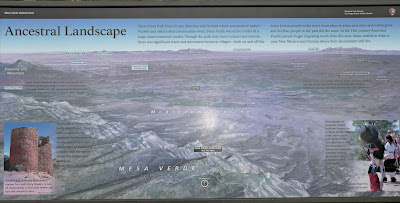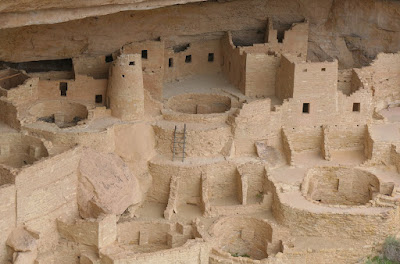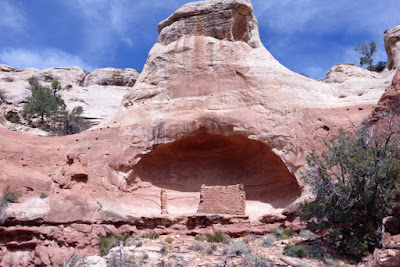On May 5th, 2024, our Off the Beaten Path small group tour left Durango and spent most of the day exploring Mesa Verde National Park. Our van first stopped at the visitor's center, followed by a winding climb to Park Point, the highest elevation in Mesa Verde at 8,572 feet (2,612 m). Even though the sky was gray, the view was spectacular, including the Sleeping Ute mountains and Shiprock. (Click on any image to enlarge.)
A plaque and our knowledgeable guide, John Ninneman, a veteran of many trips, pointed out the features of the landscape.Our road wound southwest towards the Far View Lodge and beyond.Today would feature a variety of archaeological sites and eras. When most people hear "Mesa Verde," they are aware only of the Cliff House. We saw much more!
A plaque and our knowledgeable guide, John Ninneman, a veteran of many trips, pointed out the features of the landscape.Our road wound southwest towards the Far View Lodge and beyond.Today would feature a variety of archaeological sites and eras. When most people hear "Mesa Verde," they are aware only of the Cliff House. We saw much more!
The average annual precipitation in this region is estimated to have been about 15-18 inches during its occupation, enough to allow the Ancestral Puebloans to raise corn, beans, and squash. There were drier intervals, including the mid 1100s, but it was the great drought of 1279-1299 that led to the abandonment of Mesa Verde for areas with more reliable water.
First, we stopped at the Far View farming community.Here are the external kivas.Another Far View structure ...Then, a plaque about the Far View House.The right side of the above plaque includes an image of the remaining multi-room dwelling. I took this ground-level photo.This excavation is well protected, a testament to the care and respect for history.
A fascinating, detailed kiva design!Then we piled back into the van and drove to the famous Mesa Verde Cliff Palace.
We were one week too early for the full tour season (in 2024, it began May 12th), so many of the hiking options, including the Cliff Palaceand Balcony House, were closed. I could zoom in with my camera, however,and use my binoculars. Here, you see a closed stairway.The restaurant was open, thank goodness, and became our lunch stop. Our next stop was a well-preserved pithouse, one of the earliest permanent dwellings at Mesa Verde.A plaque explained how the structure could be dated.And here we have it.
Next, we visited the view of the Square Tower House.This plaque explained the painstaking work to preserve the threatened structure.
A fascinating, detailed kiva design!Then we piled back into the van and drove to the famous Mesa Verde Cliff Palace.
We were one week too early for the full tour season (in 2024, it began May 12th), so many of the hiking options, including the Cliff Palaceand Balcony House, were closed. I could zoom in with my camera, however,and use my binoculars. Here, you see a closed stairway.The restaurant was open, thank goodness, and became our lunch stop. Our next stop was a well-preserved pithouse, one of the earliest permanent dwellings at Mesa Verde.A plaque explained how the structure could be dated.And here we have it.
Next, we visited the view of the Square Tower House.This plaque explained the painstaking work to preserve the threatened structure.
Here's our view of it.From there, it was on to the Sun Temple.A short walk took us to the obligatory plaque,
and the broad structure.We were forbidden to enter, but could peer within all we wanted.There is debate about whether the symmetrically planned "D" shape building was ever completed, but a huge amount of labor was put into it in any case: the stone masonry walls were shaped and given a "dimpled"
flat surface by the builders. Excavation of debris revealed that the walls were probably between
11 and 14 feet high -- great for secrecy. On tip-toes, I managed to get this view, which shows the concrete that prevents rain from dribbling into the rubble between the walls.By now, it was mid-afternoon, and our overnight was at least an hour and a half away in Farmington, New Mexico, where we would spend the next two nights. Tomorrow, we will have a full day to explore Chaco Canyon, one of the big draws of this itinerary for Joan and me.


















































